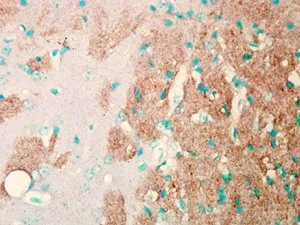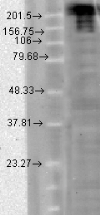
IHC analysis of Nav1.7 in mouse brain tissue using a dilution of GTX41995.
Nav1.7 antibody [S68-6]
GTX41995
ApplicationsImmunoFluorescence, ImmunoPrecipitation, Western Blot, ImmunoCytoChemistry, ImmunoHistoChemistry
Product group Antibodies
ReactivityHuman, Mouse, Rat
TargetSCN9A
Overview
- SupplierGeneTex
- Product NameNav1.7 antibody [S68-6]
- Delivery Days Customer9
- Antibody SpecificityNo cross-reactivity against other Nav channels.
- Application Supplier NoteWe recommend a working dilution of 1-10ug/mL (WB), 0.1-1.0ug/mL (Perox) (IHC/ICC), 1.0-10ug/mL (IF).
- ApplicationsImmunoFluorescence, ImmunoPrecipitation, Western Blot, ImmunoCytoChemistry, ImmunoHistoChemistry
- CertificationResearch Use Only
- ClonalityMonoclonal
- Clone IDS68-6
- Concentration1 mg/ml
- ConjugateUnconjugated
- Gene ID6335
- Target nameSCN9A
- Target descriptionsodium voltage-gated channel alpha subunit 9
- Target synonymsETHA; FEB3B; GEFSP7; hNE-Na; HSAN2D; Nav1.7; NENA; NE-NA; neuroendocrine sodium channel; peripheral sodium channel 1; PN1; SFNP; sodium channel protein type 9 subunit alpha; sodium channel protein type IX subunit alpha; sodium channel, voltage-gated, type IX, alpha polypeptide; sodium channel, voltage-gated, type IX, alpha subunit; voltage-gated sodium channel alpha subunit Nav1.7; voltage-gated sodium channel subunit alpha Nav1.7
- HostMouse
- IsotypeIgG1
- Protein IDQ15858
- Protein NameSodium channel protein type 9 subunit alpha
- Scientific DescriptionThis gene encodes a voltage-gated sodium channel which plays a significant role in nociception signaling. Mutations in this gene have been associated with primary erythermalgia, channelopathy-associated insensitivity to pain, and paroxysmal extreme pain disorder. [provided by RefSeq, Aug 2009]
- ReactivityHuman, Mouse, Rat
- Storage Instruction-20°C or -80°C,2°C to 8°C
- UNSPSC12352203

